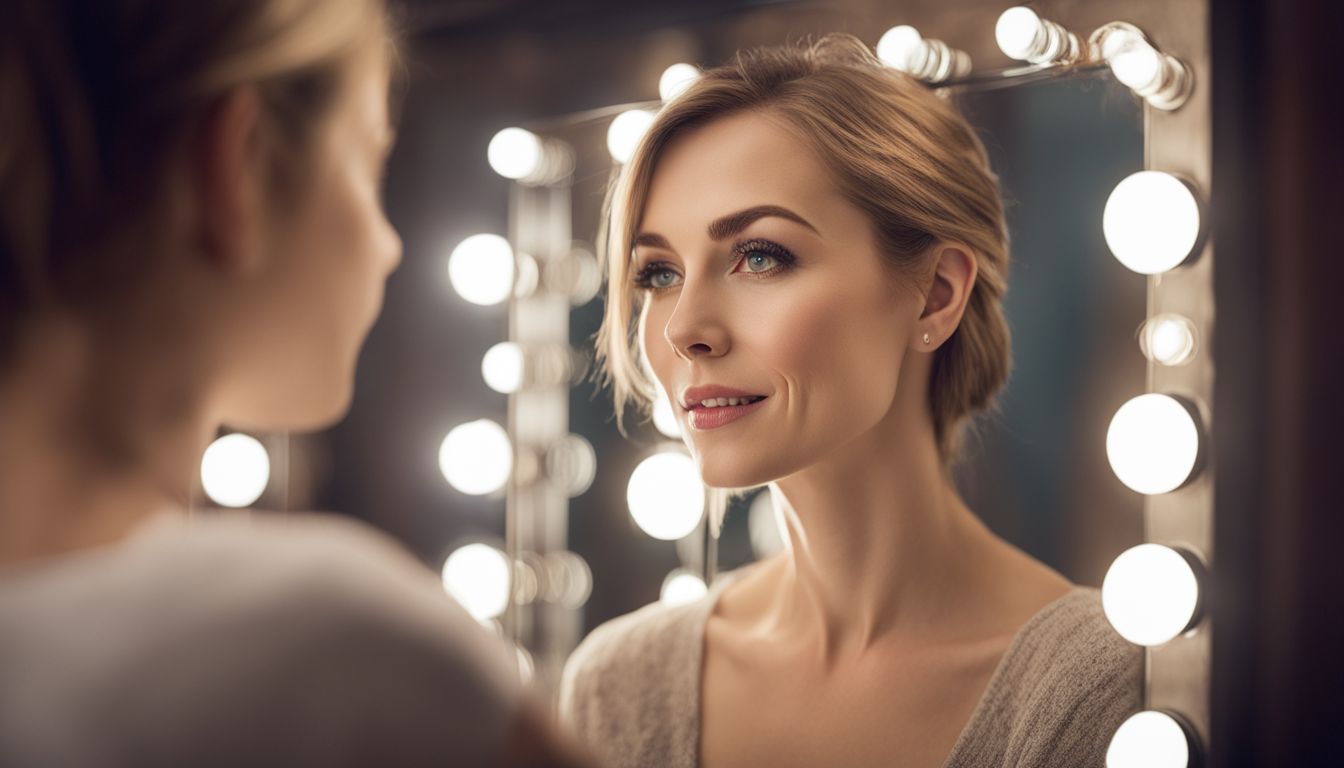Effective Minoxidil For Women: Promoting Hair Growth And Preventing Thinning
Facing thinning hair can be a distressing and all-too-common challenge for many women. Minoxidil has emerged as a beacon of hope, FDA-approved specifically for treating female pattern baldness.
Our blog post will take you through how this powerful ingredient can encourage hair regrowth and fortify your locks against future loss. Discover the fuller head of hair you deserve—let’s dive in!
Key Takeaways
- Minoxidil is a medicine that helps women grow hair and slow down balding.
- When used right, it can make new hair grow and stop old hair from falling out.
- To see good results, you must use minoxidil every day and be patient because it takes time to work.
- It’s not safe for pregnant or breastfeeding women and may have some side effects like scalp irritation.
- Always talk to a doctor before starting minoxidil to make sure it’s the right choice for you.
Understanding Female Hair Loss and Thinning

Female hair loss and thinning can be caused by a variety of factors, including genetics, hormonal changes, medical conditions, and lifestyle choices. Androgenetic alopecia is the most common type of female pattern hair loss, characterized by a gradual thinning of hair on the top and front of the scalp.
Causes of hair loss in women
Many things can make a woman’s hair fall out. The biggest cause is female pattern hair loss, also called androgenetic alopecia. This kind of hair loss happens because of genes and hormones and is very common.
But other things like stress, diet changes, or illnesses can also make hair thin or fall out.
Sometimes, women lose more hair when they have big life changes like after having a baby or during menopause. Also, tight hairstyles that pull on the scalp might cause some hairs to come loose.
Knowing these causes helps us see how treatments like minoxidil can work to fix them.
Moving forward, let’s look into different types of female pattern hair loss to understand this condition better.
Types of female pattern hair loss
Hair loss in women can happen for many reasons. Now let’s look at the different ways female pattern hair loss shows up.
- Thinning on Top: A lot of women notice that their hair is getting thin right on top of their head. This is often where hair loss starts.
- Widening Part: You might see that the part in your hair is slowly getting wider. That’s a common sign of pattern hair loss.
- Small Bald Patches: Sometimes, little bald spots can appear. They might not be very big, but they are a clear sign that something is happening with your hair.
- More Hair Shedding: Are you finding more hair in your brush? This could mean you’re in the early stages of hair thinning.
- Hair Feels Finer: Your ponytail may not feel as thick as it used to because each strand of hair can get thinner.
- Receding Hairline: Some women find their hairline going back from their forehead which is another type of female pattern hair loss.
How Minoxidil Can Help Promote Hair Growth

Minoxidil is a topical solution that stimulates hair follicles, extending the anagen phase of hair growth and increasing hair protein production. It has been clinically proven to promote hair regrowth in women with hereditary hair loss.
What is minoxidil?
Minoxidil is a drug that helps grow hair and slows down balding. It’s good for people who are losing their hair but aren’t too old or haven’t been bald for a long time. When you use it on your head, it can make new hair grow and stop old hair from falling out.
Some folks even use it to make their eyebrows or beards thicker.
This medicine comes in foam or liquid with 2 percent minoxidil just for women with thinning hair. It has helped many women get their hair back to looking full and healthy again.
How does minoxidil work?
Minoxidil stimulates hair growth on the scalp when applied topically. It works by dilating the blood vessels in the scalp, which may improve hair follicle function and stimulate hair growth.
Minoxidil can also prolong the anagen phase of hair growth, leading to increased hair shaft diameter and length. These effects can help reduce hair loss and promote new hair regrowth, making it an effective option for people experiencing thinning or balding.
When used consistently and correctly, minoxidil has shown promising results in promoting hair regrowth for individuals dealing with various types of alopecia.
Effectiveness of minoxidil for women
Minoxidil has been proven to be effective in helping women with thinning hair. Research studies have shown that when minoxidil is applied directly to the scalp, it can stimulate hair growth in women experiencing female pattern hair loss.
The FDA has approved minoxidil foam and a 2 percent solution for promoting hair growth in women with thinning hair, making it a trusted option for those looking to address their hair loss concerns.
Research studies have confirmed that minoxidil applied directly to the scalp can stimulate hair growth in women with female pattern hair loss, demonstrating its effectiveness. Additionally, the FDA has given its seal of approval by endorsing minoxidil foam and a 2 percent solution for promoting hair growth in women with thinning hair.
Tips for Using Minoxidil Effectively
Proper application techniques and consistency are key to using minoxidil effectively for promoting hair growth. It’s also important to consider combining minoxidil with other treatments for best results.
Proper application techniques
To properly apply minoxidil for effective results, follow these techniques:
- Ensure your scalp is clean and dry before applying minoxidil.
- Part your hair to expose the areas of thinning or hair loss.
- Apply the recommended amount of minoxidil directly to the affected areas.
- Gently massage the minoxidil into your scalp with your fingertips to aid absorption.
- Avoid washing or wetting your hair for at least four hours after applying minoxidil.
Consistency and patience
Consistency is key when using minoxidil for hair growth. It’s important to use it regularly as directed by your healthcare professional. Don’t expect immediate results – it may take several months before you notice any significant changes in your hair growth.
Be patient and stick with the treatment plan to give it a chance to work effectively.
Remember, consistency with minoxidil application is crucial for seeing improvements in hair growth. It’s also essential to be patient and give the treatment time to show its effectiveness.
Combining with other treatments
To maximize the benefits of minoxidil, dermatologists often recommend combining it with other medications like finasteride and retinoic acid. Research has shown that this combination can significantly improve hair regrowth in individuals with hair loss issues.
By using minoxidil alongside other treatments as advised by healthcare professionals, patients can experience enhanced results and better management of their thinning or receding hair.
Furthermore, when used in combination with other therapies, minoxidil has been found to provide remarkable benefits for women dealing with hair loss-related problems. This approach not only enhances the effectiveness of minoxidil but also offers a comprehensive strategy for promoting healthy hair growth.
Precautions and Side Effects
Before using minoxidil, it’s essential to be aware of potential risks for pregnant and breastfeeding women, as well as common side effects such as scalp irritation and changes in hair color or texture.
Understanding these precautions can help you make an informed decision about using minoxidil for promoting hair growth and preventing thinning. To learn more about how minoxidil can effectively help women with hair loss, continue reading our blog.
Potential risks for pregnant & breastfeeding women
Minoxidil can pose potential risks for pregnant and breastfeeding women. It’s not recommended for use during pregnancy or while lactating, as its effects on the fetus or infant are not fully understood.
The medication may pass into breast milk and could potentially harm the nursing baby. Therefore, it’s crucial for pregnant and breastfeeding women to carefully weigh the possible benefits of using minoxidil against the potential risks to themselves and their infants.
Consulting a healthcare professional before considering this treatment is highly advisable due to these concerns.
Furthermore, topical minoxidil should be used cautiously by breastfeeding mothers, particularly with preterm infants, as there could be risks involved even in older, full-term breastfed babies.
Common side effects
After considering potential risks for pregnant and breastfeeding women, it’s important to be aware of the common side effects of using minoxidil for promoting hair growth in women.
Acne at the application site, scalp burning, facial hair growth, increased hair loss, soreness at the hair root, and reddened skin are some typical side effects of using minoxidil.
Additionally, individuals might experience scalp irritation, rashes and unwanted hair growth when using this treatment.
When to consult a doctor
If you experience any concerns or questions about the potential side effects and precautions linked with minoxidil, it’s important to seek advice from a doctor. Complications or worries related to using minoxidil must prompt consultation with a medical professional as improper use may irritate the scalp and lead to unpleasant side effects.
It is also recommended to consult a doctor when using minoxidil for hair growth, ensuring that potential side effects are discussed and the medication is used correctly for optimal results.
Once you recognize the necessity of consulting a doctor regarding your concerns about minoxidil usage, you can take practical steps to ensure your well-being while promoting hair growth.
Conclusion
In conclusion, Minoxidil is a proven treatment for female hair loss. It can stimulate hair growth and prevent further thinning when applied consistently. Although there are potential side effects, consulting with a healthcare professional before use is essential.
With proper application and patience, Minoxidil can be an effective option for women seeking to promote hair growth and combat thinning.
FAQs
1. What is minoxidil for women and how does it help with hair loss?
Minoxidil for women, often known as Women’s Rogaine, is a scalp treatment that helps women grow hair back and prevents further thinning.
2. Can I use Women’s Rogaine if I’m breastfeeding or have allergies?
Women who are breastfeeding should not use Women’s Rogaine. If you have allergies or any skin conditions like eczema, talk to your doctor first.
3. Are there any side effects of using minoxidil for women?
Yes, some might see changes in hair color or texture, develop an itchy scalp, or even experience unwanted facial hair growth (hypertrichosis).
4. Should I talk to a doctor before trying minoxidil treatments for my hair loss?
Yes! It’s important to speak with a dermatologist recommended professional about your history of hair loss and safety information before starting any new treatment.
5. Is there another way to treat hair loss if minoxidil doesn’t work for me?
If Minoxidil isn’t right for you, other options include spironolactone pills, platelet-rich plasma injections, or even having a surgeon do hair transplants.
6. Where can I buy Women’s Rogaine safely?
You can find Women’s Rogaine at stores online like amazon.com where you checkout with your credit card safely and get the unscented foam delivered straight to your door.
References
- https://health.clevelandclinic.org/hair-loss-got-you-down-platelet-rich-plasma-may-regrow-it/
- https://www.ncbi.nlm.nih.gov/pubmed/21700360
- https://www.ncbi.nlm.nih.gov/pubmed/25807073
- https://www.medicalnewstoday.com/articles/321527.php
- https://www.healthline.com/health/womens-health/female-pattern-baldness#treatment
- https://www.regaine.co.uk/minoxidil/how-it-works
- https://www.health.harvard.edu/staying-healthy/treating-female-pattern-hair-loss
- https://www.sciencedirect.com/science/article/pii/S2352647518300224
- https://www.dermnetnz.org/topics/female-pattern-hair-loss/
- https://www.aad.org/public/skin-hair-nails/hair-care/female-pattern-hair-loss
